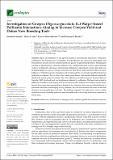Por favor, use este identificador para citar o enlazar a este item:
http://hdl.handle.net/10261/296664COMPARTIR / EXPORTAR:
 SHARE SHARE
 CORE
BASE CORE
BASE
|
|
| Visualizar otros formatos: MARC | Dublin Core | RDF | ORE | MODS | METS | DIDL | DATACITE | |

| Título: | Investigation of Cowpea (Vigna unguiculata (L.) Walp.)-Insect Pollinator Interactions Aiming to Increase Cowpea Yield and Define New Breeding Tools |
Autor: | Lazaridi, Efstathia; Suso Llamas, María José CSIC ORCID; Ortiz Sánchez, Francisco Javier; Bebeli, Penélope J. | Palabras clave: | Biodiversity Floral resources Foraging activity Landraces Production Resilient ecosystems |
Fecha de publicación: | mar-2023 | Editor: | Multidisciplinary Digital Publishing Institute | Citación: | Ecologies 4(1): 124-140 (2023) | Resumen: | Impact of pollination on the agri-food sector is of paramount importance. Pollinators contribute to the maintenance of ecosystems, the reproduction and survival of many plants, and their presence usually leads to increased yield and quality of agricultural products. Breeding and selecting for plant traits for enhancing pollinator visits could therefore lead to more resilient farming systems. In stating the advantages of enhancing pollinators in agricultural systems, this study was designed aiming to assess six cowpea accessions for their flower traits and their effect on insect-pollinators. Pollinators species abundance and foraging activity was recorded and their impact on yield was investigated. Twenty-five of the twenty-seven flower traits studied differed statistically significantly among cowpea accessions. The main pollinators recorded belonged to the genus <i>Xylocopa</i> (Latreille, 1802). Seed and fresh pod yield was not affected by pollinators. The floral traits related to pollinators abundance and foraging activity were flower color, inflorescence position and the hours that the flowers per plant remained open during the day. However, they were not related linearly to pollinators abundance and foraging activity; therefore, they did not constitute safe traits for selection aiming to increase pollinators visitation. The findings suggested that other traits, such as pollen and nectar reward, probably perform a more important role in attracting pollinators compared to flower traits. | Versión del editor: | https://doi.org/10.3390/ecologies4010010 | URI: | http://hdl.handle.net/10261/296664 | DOI: | 10.3390/ecologies4010010 | E-ISSN: | 2673-4133 |
| Aparece en las colecciones: | (IAS) Artículos |
Ficheros en este ítem:
| Fichero | Descripción | Tamaño | Formato | |
|---|---|---|---|---|
| ecologies-04-00010-v2.pdf | 2,83 MB | Adobe PDF |  Visualizar/Abrir |
CORE Recommender
SCOPUSTM
Citations
4
checked on 21-abr-2024
WEB OF SCIENCETM
Citations
2
checked on 25-feb-2024
Page view(s)
23
checked on 28-abr-2024
Download(s)
63
checked on 28-abr-2024
Google ScholarTM
Check
Altmetric
Altmetric
Este item está licenciado bajo una Licencia Creative Commons

